Business Finance: Investment Appraisal Methods and Evaluation
VerifiedAdded on 2022/10/02
|12
|2328
|63
Report
AI Summary
This report delves into the core concepts of investment appraisal within the realm of business finance. It begins by emphasizing the critical need for financial resources in business operations and the role of investment appraisal in guiding companies toward sound investment decisions. The report then provides a comprehensive overview of various investment appraisal techniques, including Net Present Value (NPV), Accounting Rate of Return (ARR), Internal Rate of Return (IRR), Modified Internal Rate of Return (MIRR), Adjusted Present Value (APV), Profitability Index (PI), Equivalent Annuity, Payback Periods, Discounted Payback Period and Real Option Analysis, explaining how each method functions and its benefits. The report illustrates these techniques with practical examples and discusses their implications for businesses, shareholders, and investors. Furthermore, the report addresses the suitability of these methods in a dynamic business environment, and whether these methods meet the needs of both investors and the wider stakeholder community, concluding with a summary of the findings and recommendations.

Running Head: BUSINESS FINANCE
Business finance
Name of the Student:
Name of the University:
Author Note:
Business finance
Name of the Student:
Name of the University:
Author Note:
Paraphrase This Document
Need a fresh take? Get an instant paraphrase of this document with our AI Paraphraser

1
BUSINESS FINANCE
Executive summary
In this report explains the need of finance in a business and how investment appraisal is helping
the companies in choosing the right investment project. Then different method of investments
appraisal are explained and how it benefits the company, shareholders and investors.
BUSINESS FINANCE
Executive summary
In this report explains the need of finance in a business and how investment appraisal is helping
the companies in choosing the right investment project. Then different method of investments
appraisal are explained and how it benefits the company, shareholders and investors.
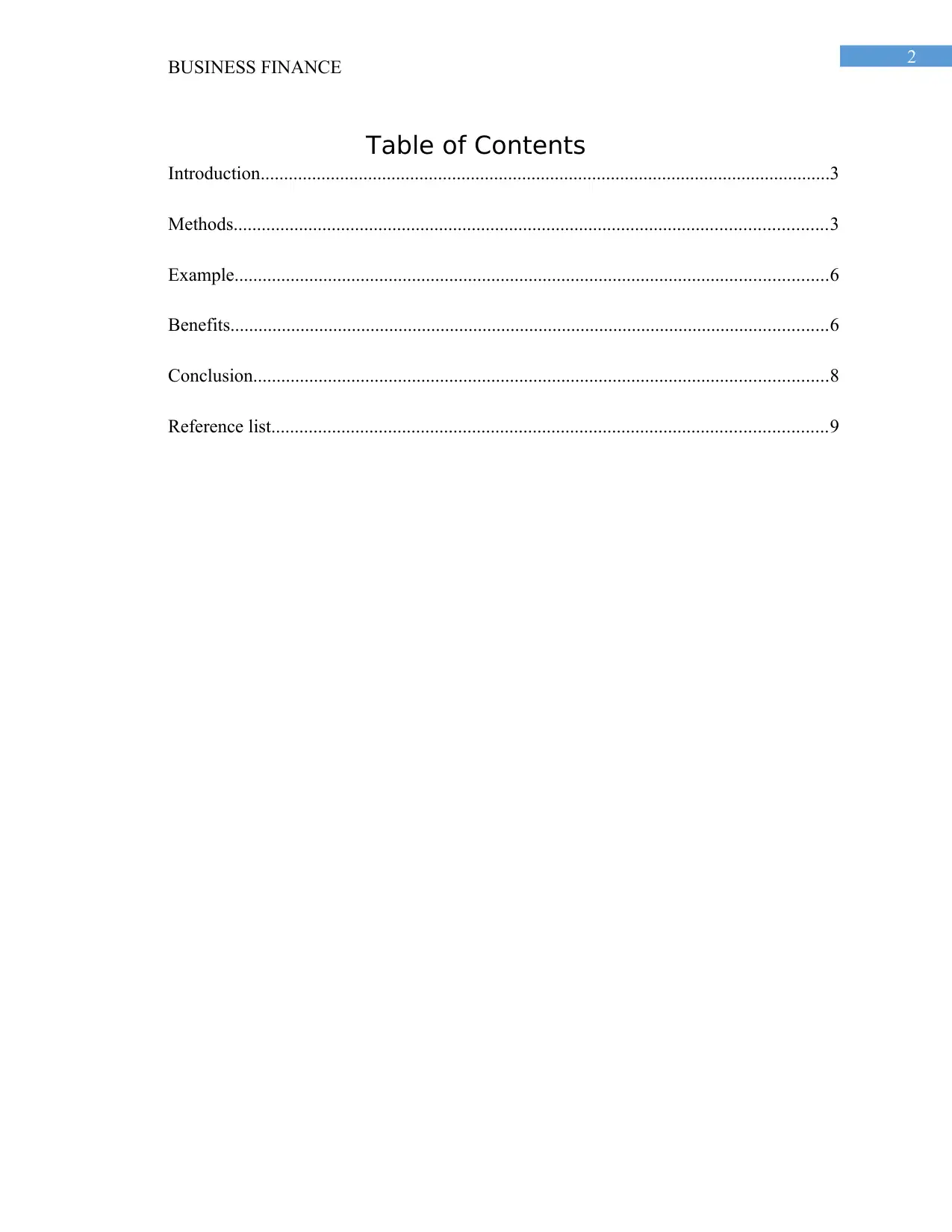
2
BUSINESS FINANCE
Table of Contents
Introduction..........................................................................................................................3
Methods...............................................................................................................................3
Example...............................................................................................................................6
Benefits................................................................................................................................6
Conclusion...........................................................................................................................8
Reference list.......................................................................................................................9
BUSINESS FINANCE
Table of Contents
Introduction..........................................................................................................................3
Methods...............................................................................................................................3
Example...............................................................................................................................6
Benefits................................................................................................................................6
Conclusion...........................................................................................................................8
Reference list.......................................................................................................................9
⊘ This is a preview!⊘
Do you want full access?
Subscribe today to unlock all pages.

Trusted by 1+ million students worldwide
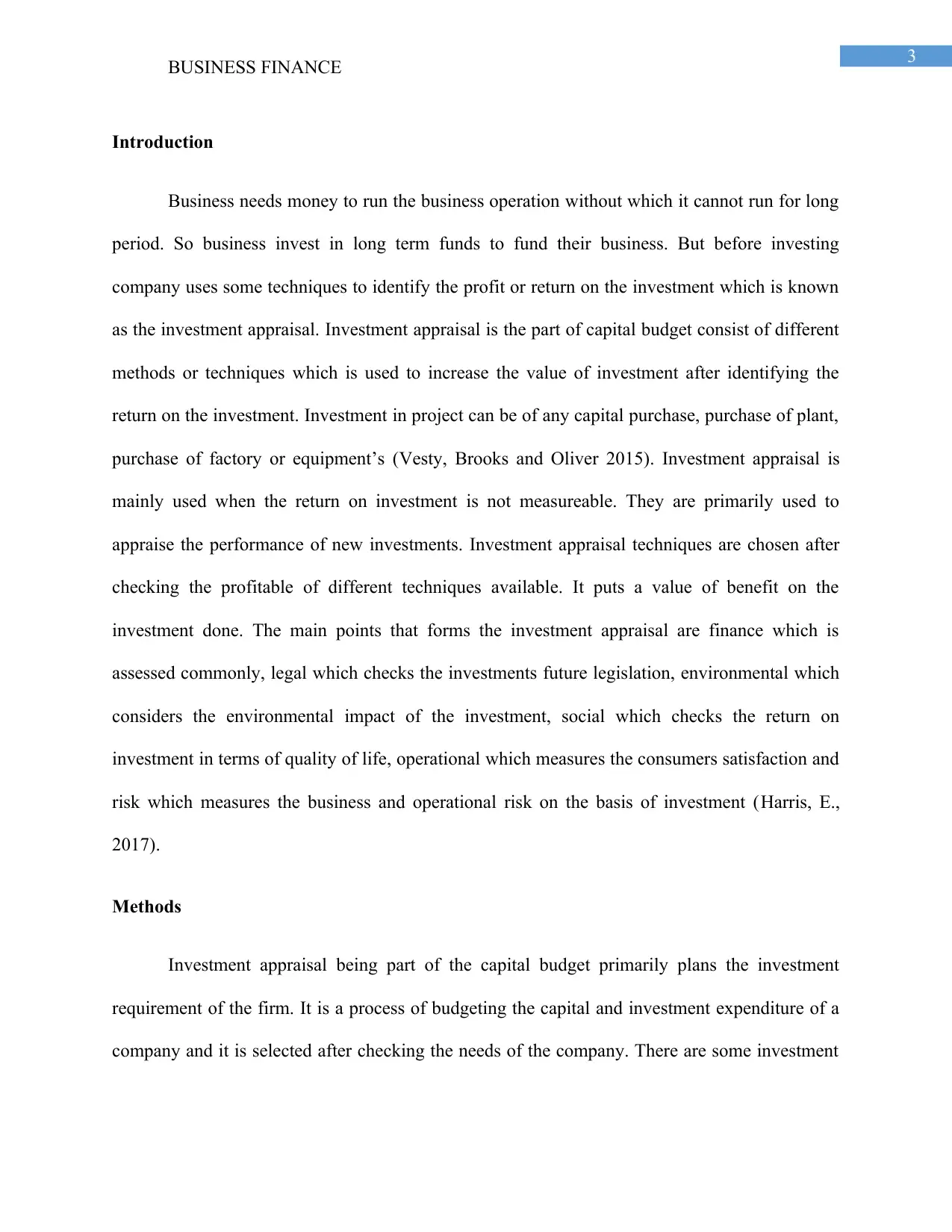
3
BUSINESS FINANCE
Introduction
Business needs money to run the business operation without which it cannot run for long
period. So business invest in long term funds to fund their business. But before investing
company uses some techniques to identify the profit or return on the investment which is known
as the investment appraisal. Investment appraisal is the part of capital budget consist of different
methods or techniques which is used to increase the value of investment after identifying the
return on the investment. Investment in project can be of any capital purchase, purchase of plant,
purchase of factory or equipment’s (Vesty, Brooks and Oliver 2015). Investment appraisal is
mainly used when the return on investment is not measureable. They are primarily used to
appraise the performance of new investments. Investment appraisal techniques are chosen after
checking the profitable of different techniques available. It puts a value of benefit on the
investment done. The main points that forms the investment appraisal are finance which is
assessed commonly, legal which checks the investments future legislation, environmental which
considers the environmental impact of the investment, social which checks the return on
investment in terms of quality of life, operational which measures the consumers satisfaction and
risk which measures the business and operational risk on the basis of investment (Harris, E.,
2017).
Methods
Investment appraisal being part of the capital budget primarily plans the investment
requirement of the firm. It is a process of budgeting the capital and investment expenditure of a
company and it is selected after checking the needs of the company. There are some investment
BUSINESS FINANCE
Introduction
Business needs money to run the business operation without which it cannot run for long
period. So business invest in long term funds to fund their business. But before investing
company uses some techniques to identify the profit or return on the investment which is known
as the investment appraisal. Investment appraisal is the part of capital budget consist of different
methods or techniques which is used to increase the value of investment after identifying the
return on the investment. Investment in project can be of any capital purchase, purchase of plant,
purchase of factory or equipment’s (Vesty, Brooks and Oliver 2015). Investment appraisal is
mainly used when the return on investment is not measureable. They are primarily used to
appraise the performance of new investments. Investment appraisal techniques are chosen after
checking the profitable of different techniques available. It puts a value of benefit on the
investment done. The main points that forms the investment appraisal are finance which is
assessed commonly, legal which checks the investments future legislation, environmental which
considers the environmental impact of the investment, social which checks the return on
investment in terms of quality of life, operational which measures the consumers satisfaction and
risk which measures the business and operational risk on the basis of investment (Harris, E.,
2017).
Methods
Investment appraisal being part of the capital budget primarily plans the investment
requirement of the firm. It is a process of budgeting the capital and investment expenditure of a
company and it is selected after checking the needs of the company. There are some investment
Paraphrase This Document
Need a fresh take? Get an instant paraphrase of this document with our AI Paraphraser

4
BUSINESS FINANCE
appraisal techniques which is used by a company before planning for any investment are as
follows:
1. Net present value – Under this technique firm measures the cash inflow in a particular
time period and determine the excess or shortfall of the return amount. It is used during
the investment planning to determine the profitability of the project. Positive NPV is
observed to confirm the investment project. It is calculated by deducting cash outflow
from cash inflow for a certain period of time. This calculation is done at a particular time
period at a given discounted rate which shows an inverse proportion between the
discounted rate and the NPV (Fokkema, Buijs and Vis 2017).
2. Accounting rate of return – Under this method firms compares the profit that they can
earn from the initial investment. It calculates the percentage of rate of return from the
investment. Investments that gives the highest amount of profit are selected. In its
calculation it may not considered time value of money. It is calculated by dividing the
annual net profit by the initial cost of asset.
3. Internal rate of return – Internal rate of return is a discount rate that takes the value of Net
present value for every project is zero. It considered the most efficient investment
appraisal techniques among all other techniques. It measures the efficiency of the capital
investment. Firms selects investment which have the highest rate of internal rate of return
and low cost of capital. If the cost of investment is greater than the internal rate of return
then the project is rejected or drop down. It is calculated by making NPV zero and then
deriving the discounted rate form it. IRR consider the time value of money over the time
period of the project to calculate the discounted rate (Eliasson et al., 2015).
BUSINESS FINANCE
appraisal techniques which is used by a company before planning for any investment are as
follows:
1. Net present value – Under this technique firm measures the cash inflow in a particular
time period and determine the excess or shortfall of the return amount. It is used during
the investment planning to determine the profitability of the project. Positive NPV is
observed to confirm the investment project. It is calculated by deducting cash outflow
from cash inflow for a certain period of time. This calculation is done at a particular time
period at a given discounted rate which shows an inverse proportion between the
discounted rate and the NPV (Fokkema, Buijs and Vis 2017).
2. Accounting rate of return – Under this method firms compares the profit that they can
earn from the initial investment. It calculates the percentage of rate of return from the
investment. Investments that gives the highest amount of profit are selected. In its
calculation it may not considered time value of money. It is calculated by dividing the
annual net profit by the initial cost of asset.
3. Internal rate of return – Internal rate of return is a discount rate that takes the value of Net
present value for every project is zero. It considered the most efficient investment
appraisal techniques among all other techniques. It measures the efficiency of the capital
investment. Firms selects investment which have the highest rate of internal rate of return
and low cost of capital. If the cost of investment is greater than the internal rate of return
then the project is rejected or drop down. It is calculated by making NPV zero and then
deriving the discounted rate form it. IRR consider the time value of money over the time
period of the project to calculate the discounted rate (Eliasson et al., 2015).
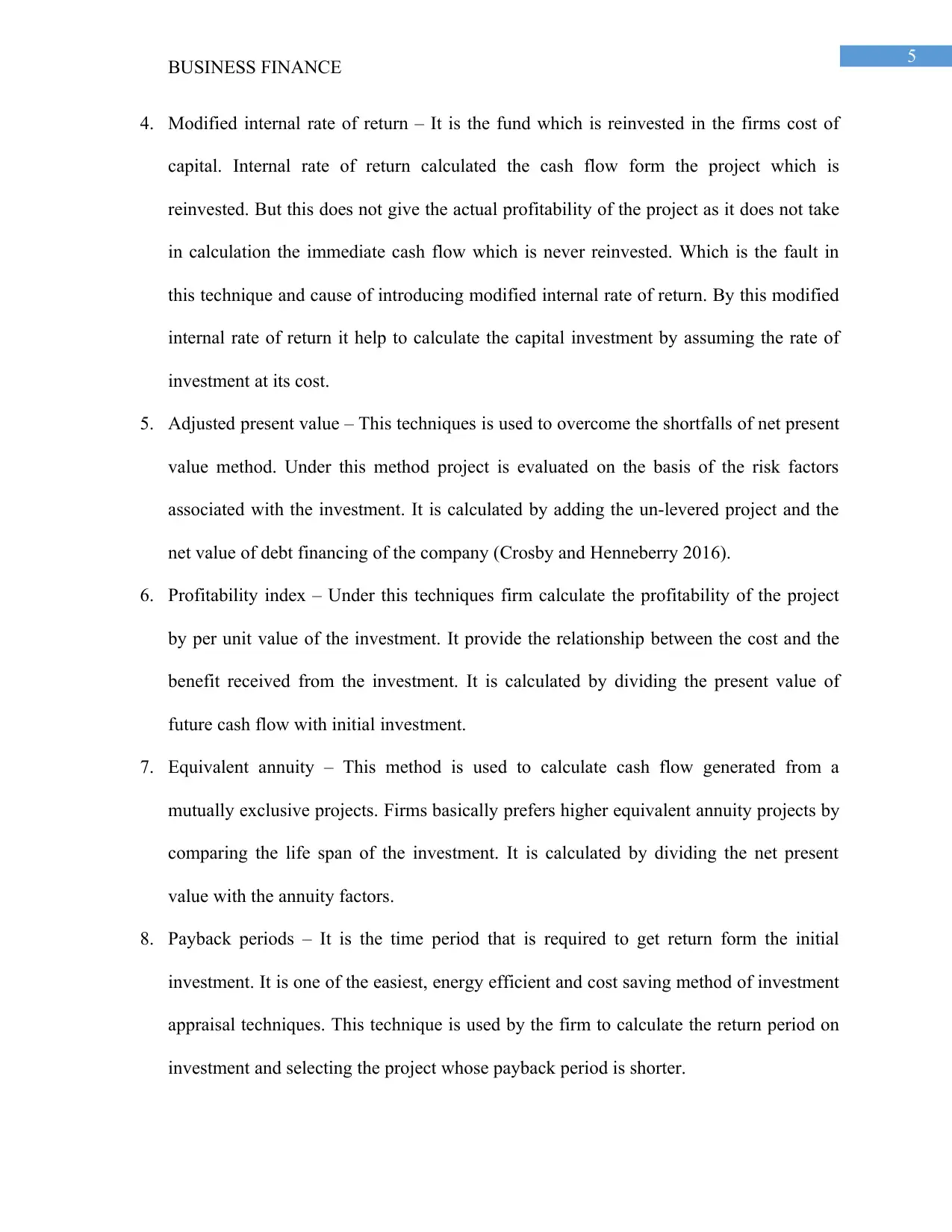
5
BUSINESS FINANCE
4. Modified internal rate of return – It is the fund which is reinvested in the firms cost of
capital. Internal rate of return calculated the cash flow form the project which is
reinvested. But this does not give the actual profitability of the project as it does not take
in calculation the immediate cash flow which is never reinvested. Which is the fault in
this technique and cause of introducing modified internal rate of return. By this modified
internal rate of return it help to calculate the capital investment by assuming the rate of
investment at its cost.
5. Adjusted present value – This techniques is used to overcome the shortfalls of net present
value method. Under this method project is evaluated on the basis of the risk factors
associated with the investment. It is calculated by adding the un-levered project and the
net value of debt financing of the company (Crosby and Henneberry 2016).
6. Profitability index – Under this techniques firm calculate the profitability of the project
by per unit value of the investment. It provide the relationship between the cost and the
benefit received from the investment. It is calculated by dividing the present value of
future cash flow with initial investment.
7. Equivalent annuity – This method is used to calculate cash flow generated from a
mutually exclusive projects. Firms basically prefers higher equivalent annuity projects by
comparing the life span of the investment. It is calculated by dividing the net present
value with the annuity factors.
8. Payback periods – It is the time period that is required to get return form the initial
investment. It is one of the easiest, energy efficient and cost saving method of investment
appraisal techniques. This technique is used by the firm to calculate the return period on
investment and selecting the project whose payback period is shorter.
BUSINESS FINANCE
4. Modified internal rate of return – It is the fund which is reinvested in the firms cost of
capital. Internal rate of return calculated the cash flow form the project which is
reinvested. But this does not give the actual profitability of the project as it does not take
in calculation the immediate cash flow which is never reinvested. Which is the fault in
this technique and cause of introducing modified internal rate of return. By this modified
internal rate of return it help to calculate the capital investment by assuming the rate of
investment at its cost.
5. Adjusted present value – This techniques is used to overcome the shortfalls of net present
value method. Under this method project is evaluated on the basis of the risk factors
associated with the investment. It is calculated by adding the un-levered project and the
net value of debt financing of the company (Crosby and Henneberry 2016).
6. Profitability index – Under this techniques firm calculate the profitability of the project
by per unit value of the investment. It provide the relationship between the cost and the
benefit received from the investment. It is calculated by dividing the present value of
future cash flow with initial investment.
7. Equivalent annuity – This method is used to calculate cash flow generated from a
mutually exclusive projects. Firms basically prefers higher equivalent annuity projects by
comparing the life span of the investment. It is calculated by dividing the net present
value with the annuity factors.
8. Payback periods – It is the time period that is required to get return form the initial
investment. It is one of the easiest, energy efficient and cost saving method of investment
appraisal techniques. This technique is used by the firm to calculate the return period on
investment and selecting the project whose payback period is shorter.
⊘ This is a preview!⊘
Do you want full access?
Subscribe today to unlock all pages.

Trusted by 1+ million students worldwide
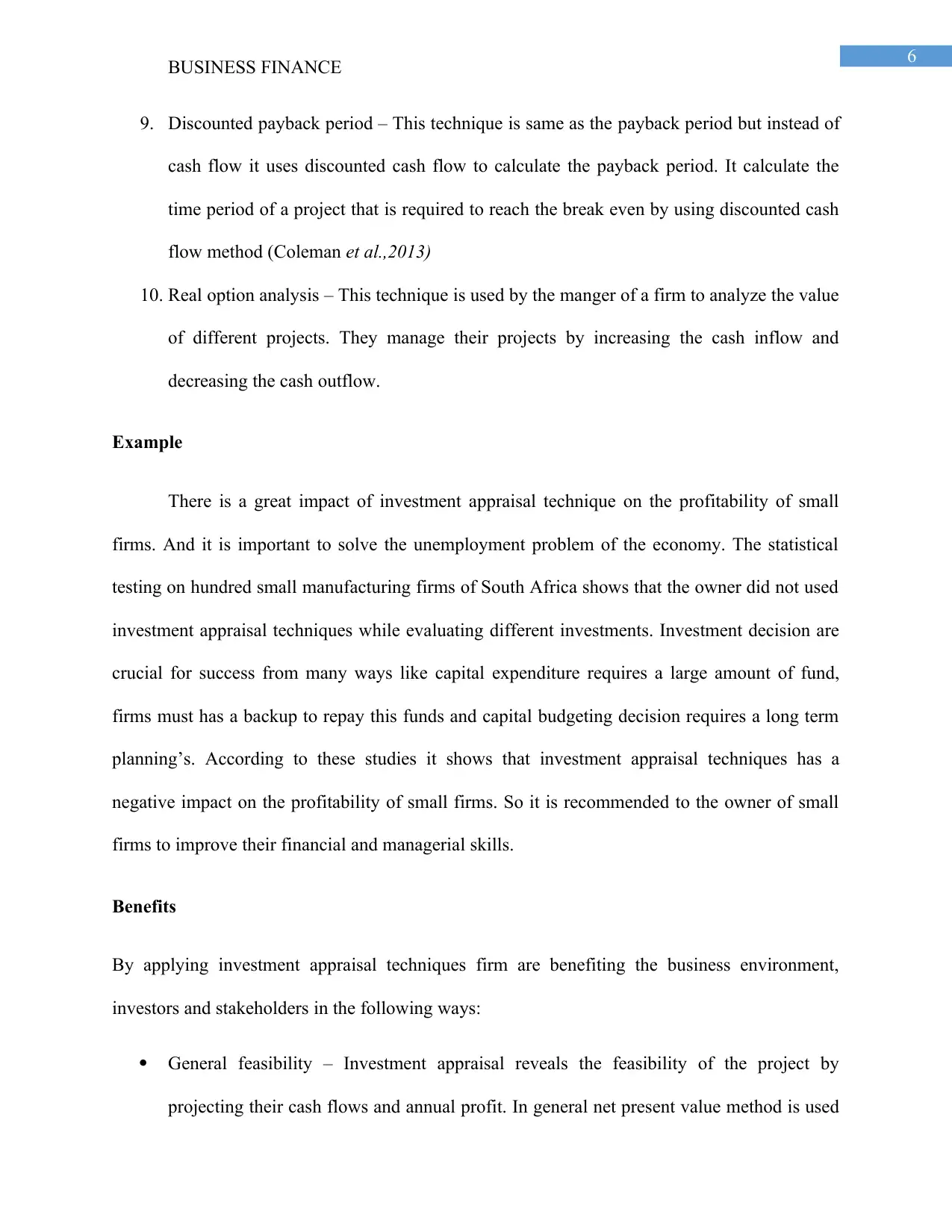
6
BUSINESS FINANCE
9. Discounted payback period – This technique is same as the payback period but instead of
cash flow it uses discounted cash flow to calculate the payback period. It calculate the
time period of a project that is required to reach the break even by using discounted cash
flow method (Coleman et al.,2013)
10. Real option analysis – This technique is used by the manger of a firm to analyze the value
of different projects. They manage their projects by increasing the cash inflow and
decreasing the cash outflow.
Example
There is a great impact of investment appraisal technique on the profitability of small
firms. And it is important to solve the unemployment problem of the economy. The statistical
testing on hundred small manufacturing firms of South Africa shows that the owner did not used
investment appraisal techniques while evaluating different investments. Investment decision are
crucial for success from many ways like capital expenditure requires a large amount of fund,
firms must has a backup to repay this funds and capital budgeting decision requires a long term
planning’s. According to these studies it shows that investment appraisal techniques has a
negative impact on the profitability of small firms. So it is recommended to the owner of small
firms to improve their financial and managerial skills.
Benefits
By applying investment appraisal techniques firm are benefiting the business environment,
investors and stakeholders in the following ways:
General feasibility – Investment appraisal reveals the feasibility of the project by
projecting their cash flows and annual profit. In general net present value method is used
BUSINESS FINANCE
9. Discounted payback period – This technique is same as the payback period but instead of
cash flow it uses discounted cash flow to calculate the payback period. It calculate the
time period of a project that is required to reach the break even by using discounted cash
flow method (Coleman et al.,2013)
10. Real option analysis – This technique is used by the manger of a firm to analyze the value
of different projects. They manage their projects by increasing the cash inflow and
decreasing the cash outflow.
Example
There is a great impact of investment appraisal technique on the profitability of small
firms. And it is important to solve the unemployment problem of the economy. The statistical
testing on hundred small manufacturing firms of South Africa shows that the owner did not used
investment appraisal techniques while evaluating different investments. Investment decision are
crucial for success from many ways like capital expenditure requires a large amount of fund,
firms must has a backup to repay this funds and capital budgeting decision requires a long term
planning’s. According to these studies it shows that investment appraisal techniques has a
negative impact on the profitability of small firms. So it is recommended to the owner of small
firms to improve their financial and managerial skills.
Benefits
By applying investment appraisal techniques firm are benefiting the business environment,
investors and stakeholders in the following ways:
General feasibility – Investment appraisal reveals the feasibility of the project by
projecting their cash flows and annual profit. In general net present value method is used
Paraphrase This Document
Need a fresh take? Get an instant paraphrase of this document with our AI Paraphraser
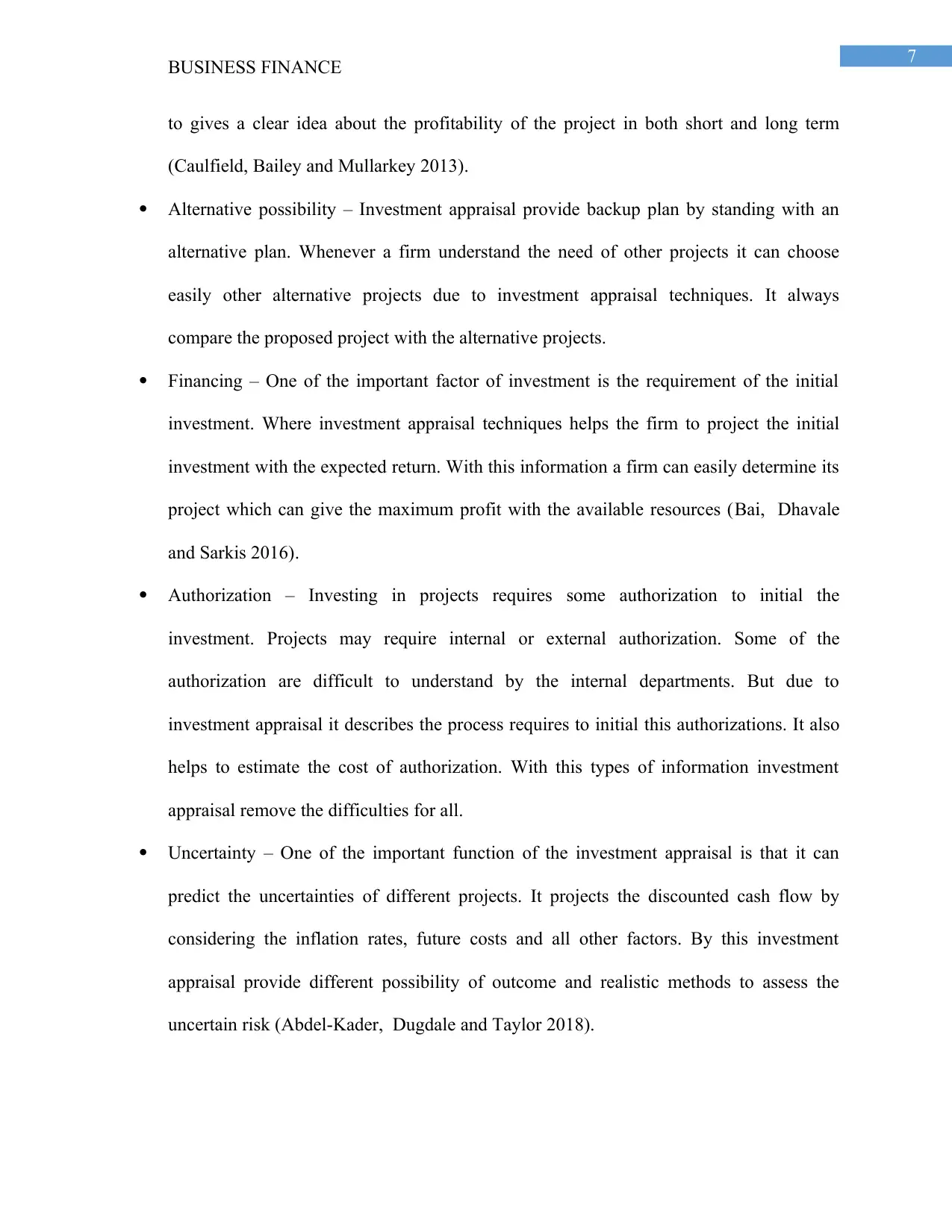
7
BUSINESS FINANCE
to gives a clear idea about the profitability of the project in both short and long term
(Caulfield, Bailey and Mullarkey 2013).
Alternative possibility – Investment appraisal provide backup plan by standing with an
alternative plan. Whenever a firm understand the need of other projects it can choose
easily other alternative projects due to investment appraisal techniques. It always
compare the proposed project with the alternative projects.
Financing – One of the important factor of investment is the requirement of the initial
investment. Where investment appraisal techniques helps the firm to project the initial
investment with the expected return. With this information a firm can easily determine its
project which can give the maximum profit with the available resources (Bai, Dhavale
and Sarkis 2016).
Authorization – Investing in projects requires some authorization to initial the
investment. Projects may require internal or external authorization. Some of the
authorization are difficult to understand by the internal departments. But due to
investment appraisal it describes the process requires to initial this authorizations. It also
helps to estimate the cost of authorization. With this types of information investment
appraisal remove the difficulties for all.
Uncertainty – One of the important function of the investment appraisal is that it can
predict the uncertainties of different projects. It projects the discounted cash flow by
considering the inflation rates, future costs and all other factors. By this investment
appraisal provide different possibility of outcome and realistic methods to assess the
uncertain risk (Abdel-Kader, Dugdale and Taylor 2018).
BUSINESS FINANCE
to gives a clear idea about the profitability of the project in both short and long term
(Caulfield, Bailey and Mullarkey 2013).
Alternative possibility – Investment appraisal provide backup plan by standing with an
alternative plan. Whenever a firm understand the need of other projects it can choose
easily other alternative projects due to investment appraisal techniques. It always
compare the proposed project with the alternative projects.
Financing – One of the important factor of investment is the requirement of the initial
investment. Where investment appraisal techniques helps the firm to project the initial
investment with the expected return. With this information a firm can easily determine its
project which can give the maximum profit with the available resources (Bai, Dhavale
and Sarkis 2016).
Authorization – Investing in projects requires some authorization to initial the
investment. Projects may require internal or external authorization. Some of the
authorization are difficult to understand by the internal departments. But due to
investment appraisal it describes the process requires to initial this authorizations. It also
helps to estimate the cost of authorization. With this types of information investment
appraisal remove the difficulties for all.
Uncertainty – One of the important function of the investment appraisal is that it can
predict the uncertainties of different projects. It projects the discounted cash flow by
considering the inflation rates, future costs and all other factors. By this investment
appraisal provide different possibility of outcome and realistic methods to assess the
uncertain risk (Abdel-Kader, Dugdale and Taylor 2018).
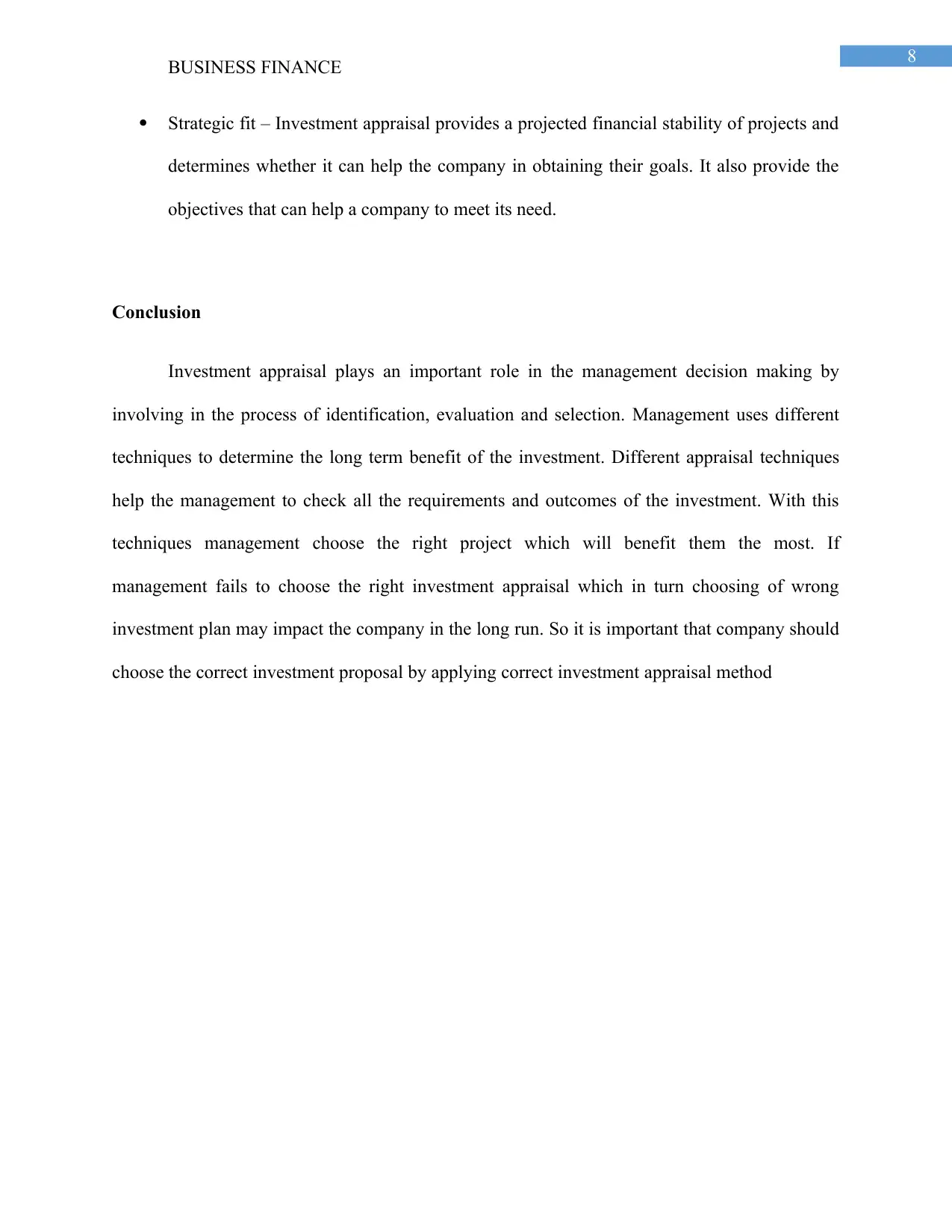
8
BUSINESS FINANCE
Strategic fit – Investment appraisal provides a projected financial stability of projects and
determines whether it can help the company in obtaining their goals. It also provide the
objectives that can help a company to meet its need.
Conclusion
Investment appraisal plays an important role in the management decision making by
involving in the process of identification, evaluation and selection. Management uses different
techniques to determine the long term benefit of the investment. Different appraisal techniques
help the management to check all the requirements and outcomes of the investment. With this
techniques management choose the right project which will benefit them the most. If
management fails to choose the right investment appraisal which in turn choosing of wrong
investment plan may impact the company in the long run. So it is important that company should
choose the correct investment proposal by applying correct investment appraisal method
BUSINESS FINANCE
Strategic fit – Investment appraisal provides a projected financial stability of projects and
determines whether it can help the company in obtaining their goals. It also provide the
objectives that can help a company to meet its need.
Conclusion
Investment appraisal plays an important role in the management decision making by
involving in the process of identification, evaluation and selection. Management uses different
techniques to determine the long term benefit of the investment. Different appraisal techniques
help the management to check all the requirements and outcomes of the investment. With this
techniques management choose the right project which will benefit them the most. If
management fails to choose the right investment appraisal which in turn choosing of wrong
investment plan may impact the company in the long run. So it is important that company should
choose the correct investment proposal by applying correct investment appraisal method
⊘ This is a preview!⊘
Do you want full access?
Subscribe today to unlock all pages.

Trusted by 1+ million students worldwide
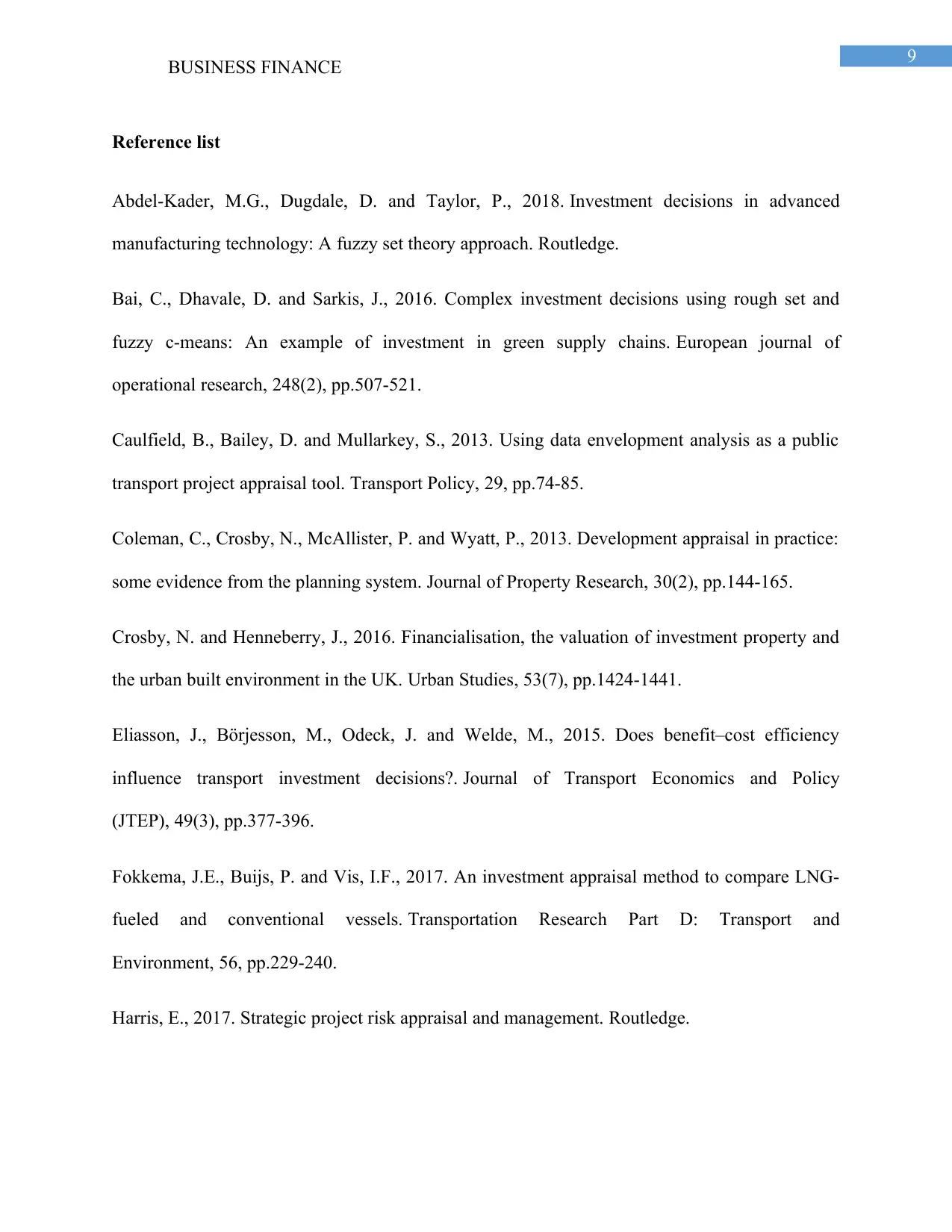
9
BUSINESS FINANCE
Reference list
Abdel-Kader, M.G., Dugdale, D. and Taylor, P., 2018. Investment decisions in advanced
manufacturing technology: A fuzzy set theory approach. Routledge.
Bai, C., Dhavale, D. and Sarkis, J., 2016. Complex investment decisions using rough set and
fuzzy c-means: An example of investment in green supply chains. European journal of
operational research, 248(2), pp.507-521.
Caulfield, B., Bailey, D. and Mullarkey, S., 2013. Using data envelopment analysis as a public
transport project appraisal tool. Transport Policy, 29, pp.74-85.
Coleman, C., Crosby, N., McAllister, P. and Wyatt, P., 2013. Development appraisal in practice:
some evidence from the planning system. Journal of Property Research, 30(2), pp.144-165.
Crosby, N. and Henneberry, J., 2016. Financialisation, the valuation of investment property and
the urban built environment in the UK. Urban Studies, 53(7), pp.1424-1441.
Eliasson, J., Börjesson, M., Odeck, J. and Welde, M., 2015. Does benefit–cost efficiency
influence transport investment decisions?. Journal of Transport Economics and Policy
(JTEP), 49(3), pp.377-396.
Fokkema, J.E., Buijs, P. and Vis, I.F., 2017. An investment appraisal method to compare LNG-
fueled and conventional vessels. Transportation Research Part D: Transport and
Environment, 56, pp.229-240.
Harris, E., 2017. Strategic project risk appraisal and management. Routledge.
BUSINESS FINANCE
Reference list
Abdel-Kader, M.G., Dugdale, D. and Taylor, P., 2018. Investment decisions in advanced
manufacturing technology: A fuzzy set theory approach. Routledge.
Bai, C., Dhavale, D. and Sarkis, J., 2016. Complex investment decisions using rough set and
fuzzy c-means: An example of investment in green supply chains. European journal of
operational research, 248(2), pp.507-521.
Caulfield, B., Bailey, D. and Mullarkey, S., 2013. Using data envelopment analysis as a public
transport project appraisal tool. Transport Policy, 29, pp.74-85.
Coleman, C., Crosby, N., McAllister, P. and Wyatt, P., 2013. Development appraisal in practice:
some evidence from the planning system. Journal of Property Research, 30(2), pp.144-165.
Crosby, N. and Henneberry, J., 2016. Financialisation, the valuation of investment property and
the urban built environment in the UK. Urban Studies, 53(7), pp.1424-1441.
Eliasson, J., Börjesson, M., Odeck, J. and Welde, M., 2015. Does benefit–cost efficiency
influence transport investment decisions?. Journal of Transport Economics and Policy
(JTEP), 49(3), pp.377-396.
Fokkema, J.E., Buijs, P. and Vis, I.F., 2017. An investment appraisal method to compare LNG-
fueled and conventional vessels. Transportation Research Part D: Transport and
Environment, 56, pp.229-240.
Harris, E., 2017. Strategic project risk appraisal and management. Routledge.
Paraphrase This Document
Need a fresh take? Get an instant paraphrase of this document with our AI Paraphraser
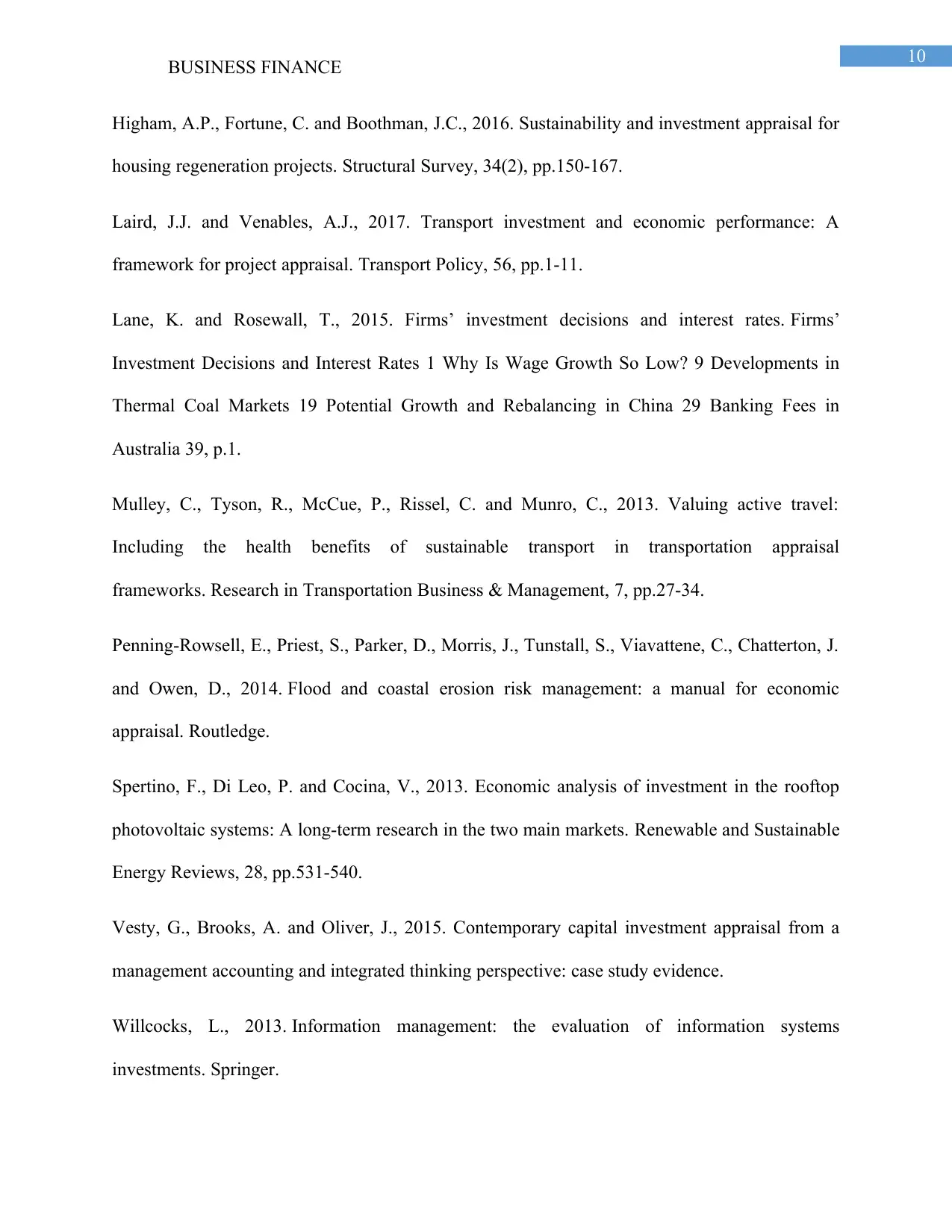
10
BUSINESS FINANCE
Higham, A.P., Fortune, C. and Boothman, J.C., 2016. Sustainability and investment appraisal for
housing regeneration projects. Structural Survey, 34(2), pp.150-167.
Laird, J.J. and Venables, A.J., 2017. Transport investment and economic performance: A
framework for project appraisal. Transport Policy, 56, pp.1-11.
Lane, K. and Rosewall, T., 2015. Firms’ investment decisions and interest rates. Firms’
Investment Decisions and Interest Rates 1 Why Is Wage Growth So Low? 9 Developments in
Thermal Coal Markets 19 Potential Growth and Rebalancing in China 29 Banking Fees in
Australia 39, p.1.
Mulley, C., Tyson, R., McCue, P., Rissel, C. and Munro, C., 2013. Valuing active travel:
Including the health benefits of sustainable transport in transportation appraisal
frameworks. Research in Transportation Business & Management, 7, pp.27-34.
Penning-Rowsell, E., Priest, S., Parker, D., Morris, J., Tunstall, S., Viavattene, C., Chatterton, J.
and Owen, D., 2014. Flood and coastal erosion risk management: a manual for economic
appraisal. Routledge.
Spertino, F., Di Leo, P. and Cocina, V., 2013. Economic analysis of investment in the rooftop
photovoltaic systems: A long-term research in the two main markets. Renewable and Sustainable
Energy Reviews, 28, pp.531-540.
Vesty, G., Brooks, A. and Oliver, J., 2015. Contemporary capital investment appraisal from a
management accounting and integrated thinking perspective: case study evidence.
Willcocks, L., 2013. Information management: the evaluation of information systems
investments. Springer.
BUSINESS FINANCE
Higham, A.P., Fortune, C. and Boothman, J.C., 2016. Sustainability and investment appraisal for
housing regeneration projects. Structural Survey, 34(2), pp.150-167.
Laird, J.J. and Venables, A.J., 2017. Transport investment and economic performance: A
framework for project appraisal. Transport Policy, 56, pp.1-11.
Lane, K. and Rosewall, T., 2015. Firms’ investment decisions and interest rates. Firms’
Investment Decisions and Interest Rates 1 Why Is Wage Growth So Low? 9 Developments in
Thermal Coal Markets 19 Potential Growth and Rebalancing in China 29 Banking Fees in
Australia 39, p.1.
Mulley, C., Tyson, R., McCue, P., Rissel, C. and Munro, C., 2013. Valuing active travel:
Including the health benefits of sustainable transport in transportation appraisal
frameworks. Research in Transportation Business & Management, 7, pp.27-34.
Penning-Rowsell, E., Priest, S., Parker, D., Morris, J., Tunstall, S., Viavattene, C., Chatterton, J.
and Owen, D., 2014. Flood and coastal erosion risk management: a manual for economic
appraisal. Routledge.
Spertino, F., Di Leo, P. and Cocina, V., 2013. Economic analysis of investment in the rooftop
photovoltaic systems: A long-term research in the two main markets. Renewable and Sustainable
Energy Reviews, 28, pp.531-540.
Vesty, G., Brooks, A. and Oliver, J., 2015. Contemporary capital investment appraisal from a
management accounting and integrated thinking perspective: case study evidence.
Willcocks, L., 2013. Information management: the evaluation of information systems
investments. Springer.

11
BUSINESS FINANCE
BUSINESS FINANCE
⊘ This is a preview!⊘
Do you want full access?
Subscribe today to unlock all pages.

Trusted by 1+ million students worldwide
1 out of 12
Related Documents
Your All-in-One AI-Powered Toolkit for Academic Success.
+13062052269
info@desklib.com
Available 24*7 on WhatsApp / Email
![[object Object]](/_next/static/media/star-bottom.7253800d.svg)
Unlock your academic potential
Copyright © 2020–2025 A2Z Services. All Rights Reserved. Developed and managed by ZUCOL.



